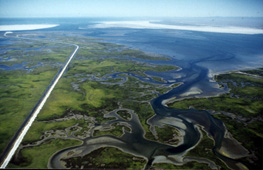 |
 |
 |
 |
 |
 |
 |
Gray Whale Migration Update: February 7, 2001
Today's Report Includes:
- On the Whale Trail
- A Whale of a Baby
- Ideal Nurseries: Challenge Question #1
- Teacher Tip
- Got Milk? Challenge Question #2
- The Journey North Begins!
On the Whale Trail
|
Gray Whale Nurseries |
A Whale of a Baby!
 |
"The baby still shows the deep facial folds that are common on babies a week and less in age--sort of like a rumpled shirt that's been stuck in the laundry basket, then finally taken out and placed on a hanger. We also saw another, younger female and baby who seemed to be swimming along. We think the slightly smaller female was acting as nursemaid or helper. We saw breeching whales, head-standing whales, hundreds of mother-and-baby pairs, and a very friendly and curious older female who approached our boat numerous times. She came so close we could count her facial hairs."
Ideal Nurseries
 |
For gray whales, these lagoons have many qualities that make them worth swimming five or six thousand miles to reach. You'll see why when you read the following account about gray whale mothers and babies. Then come back to answer our first challenge question.
Challenge Question #1
"What are at least three reasons why Mexico's lagoons make such good whale nurseries? Why is each reason important to gray whales during their breeding and calving season?"
(To respond to this question, please follow the
instructions below.)
Teacher Tip
As a class, identify key words in the text above and in "Holy Cow! What a Calf." List words, or make
a concept map or word web for nursery lagoons. Discuss why each key word might be important to gray whale adults
or newborn calves. Then send us your response to Challenge Question #1.
Got Milk?
By our next report, some of the whales will be gone from the lagoons and headed on the journey north. For the babies, the race to build blubber has begun. How long did it take you to double your weight after you were born? You did all your growing on a diet of milk. So do baby whales--but they may gain more than 60 pounds a day! Look for clues in "Holy Cow! What a Calf" and you'll be able to answer our next challenge question.
Challenge Question #2
"About how much will a calf weigh by the time it is two months old and begins the long migration north? Why is this weigh gain important?"
(To respond to this question, please follow the
instructions below.)
The Journey North Begins!
Whales are still streaming south, but the American Cetacean Society's (ACS) observation post on Palos Verde Peninsula (33.44N,-118.24W) has just reported three northbound whales! You can see the daily counts for yourself from Web sites of the ACS as well as Monterey Bay Whale Watch (36.37N,-121.54W). As the whales move northward up the coast, we'll be hearing first sightings and news from a network of observers along the way. Stay tuned!
- American Cetacean Society--Gray Whale Census and Behavior Project
- Monterey Bay Whale Watch--Marine Mammal Sightings
How to Respond to Today's Challenge Questions:
IMPORTANT: Answer only ONE question in each e-mail message.
1. Address an e-mail message to: jn-challenge-gwhale@learner.org
2. In the Subject Line of your message write: Challenge Question #1 (or #2).
3. In the body of EACH message, give your answer to ONE of the questions above.
The Next Gray Whale Migration Update Will Be Posted on February 21, 2001
Copyright 2001 Journey North. All Rights Reserved. Please send all questions, comments, and suggestions to our feedback form
 |
 |
 |
 |
 |
 |

